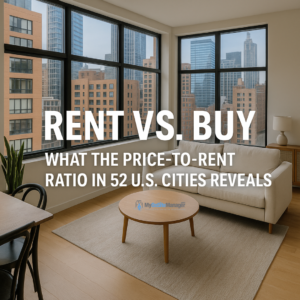
In the current real estate climate, deciding whether to rent or buy a home isn’t just a personal choice it’s an economic one. With home prices remaining elevated and mortgage rates adding pressure, many Americans are asking the same question: “Is it cheaper to rent or buy right now?”
A recent report on the price-to-rent ratio across 52 major U.S. cities offers some much-needed clarity. This key metric helps prospective buyers, renters, and investors understand where housing markets are more favorable to ownershipand where renting remains the smarter financial move.
What Is the Price-to-Rent Ratio?
The price-to-rent ratio compares the cost of buying a typical home to the cost of renting that same property for a year.
-
A low ratio (typically below 18) suggests buying may be more cost-effective than renting.
-
A moderate ratio (between 18 and 21) indicates a more balanced market.
-
A high ratio (above 21) points to renting as the more affordable option.
In simple terms, the ratio reflects how many years of rent it would take to equal the cost of buying. For example, a ratio of 25 means it would take 25 years of rent payments to match the price of a home.
Key Findings from the 52-City Analysis
According to the recent study, many U.S. cities are showing high price-to-rent ratios, signaling that renting is often cheaper in the short to medium term:
-
Expensive metro areas are becoming renter-friendly: Cities with soaring home prices, like those on the West Coast and in parts of the Northeast, now have price-to-rent ratios well above the national average. This means renting offers a lower monthly cost compared to buying in these areas.
-
Some cities still favor buyers: A few markets maintain relatively lower ratios, indicating that purchasing a home remains a competitive and potentially advantageous choice. These are often mid-sized cities or regions with slower price growth.
-
Market dynamics are shifting: The gap between rent and purchase prices is widening in several urban areas, making it harder for many would-be buyers to enter the market.
This trend mirrors the broader reality of 2025’s housing market: elevated home prices, persistent demand, and constrained affordability.
Why the Price-to-Rent Ratio Matters
For anyone making housing decisions, this ratio serves as a powerful financial guidepost:
-
For renters: It highlights cities where it may be more sensible to keep renting rather than rushing into a high-cost mortgage.
-
For buyers: Even if homeownership has long-term wealth-building benefits, buying in a high-ratio market may lead to higher monthly expenses and financial strain.
-
For investors: The ratio can indicate whether a market offers good rental yield opportunities or if properties are overvalued relative to rental income.
This makes the metric not just a headline number but a strategic decision-making tool.
Factors That Can Influence the Ratio
While the price-to-rent ratio is a useful benchmark, it doesn’t tell the whole story. Other factors can tilt the rent-versus-buy decision:
-
Mortgage rates and financing costs
High mortgage rates can make buying more expensive, even in cities with moderate price-to-rent ratios. -
Taxes, insurance, and maintenance
Owning a home involves property taxes, insurance premiums, and upkeep costs that renters don’t shoulder. -
Home value appreciation
If a city is expected to see strong home value growth, buying could still be a wise investment despite a higher ratio. -
Local job markets and amenities
Economic growth, quality of life, and infrastructure all shape housing demand and price trends. -
Lifestyle and flexibility
Renting allows for mobility and lower upfront costs, while buying offers long-term stability and equity building.
What This Means for Buyers and Renters in 2025
The price-to-rent ratio snapshot suggests that renting is currently the more affordable option in many major cities, particularly those with rapid price growth over the last few years. This doesn’t mean buying is a bad decision but it does mean buyers need to be more strategic than ever.
-
If you’re a renter, it might make sense to continue renting while building your savings and waiting for market conditions to stabilize.
-
If you’re a buyer, explore markets with lower ratios or consider creative financing options to offset high interest rates.
-
If you’re an investor, high ratios may signal opportunities in rental markets where demand is strong.
Final Thoughts
The rent-versus-buy debate isn’t going away anytime soon. As housing affordability challenges continue, tools like the price-to-rent ratio help bring clarity and context to one of the biggest financial decisions people make in their lives.
Whether you choose to rent or buy in 2025, understanding this ratio and what it means for your city can help ensure your next move is a smart one.
Source: Price-to-Rent Ratio in 52 U.S. Cities via Yahoo Finance / SoFi / AOL
